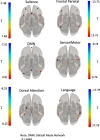Functional connectivity and quality of life in young adults with cerebral palsy: a feasibility study
- PMID: 33096988
- PMCID: PMC7583292
- DOI: 10.1186/s12883-020-01950-7
Functional connectivity and quality of life in young adults with cerebral palsy: a feasibility study
Abstract
Background: Cerebral Palsy (CP) is a group of disorders that affect the development of movement and posture. CP results from injuries to the immature brain during the prenatal, perinatal, or postnatal stage of development. Neuroimaging research in CP has focused on the structural changes of the brain during early development, but little is known about brain's structural and functional changes during late adolescence and early adulthood, a period in time when individuals experience major changes as they transition into adulthood. The work reported here served as a feasibility study within a larger program of research (MyStory Study). We aimed to determine whether it would be feasible to scan and obtain good quality data without the use of sedation during a resting state condition for functional connectivity (FC) analyses in young adults with CP. Second, we aimed to identify the FC pattern(s) that are associated with depressive mood ratings, indices of pain and fatigue, and quality of life in this group.
Methods: Resting state functional images were collected from 9 young people with CP (18-29 years). We applied a stringent head motion correction and quality control methods following preprocessing.
Results: We were able to scan and obtain good quality data without the use of sedation from this group of young individuals with CP who demonstrated a range of gross motor ability. The functional connectivity networks of interest were identified in the data using standard seed regions. Our analyses further revealed that higher well-being scores were associated with higher levels of FC between the Medial Pre-Frontal Cortex and the right Lateral Parietal regions, which are implicated in prosocial and emotion regulations skills. The implications of this association are discussed.
Conclusion: The findings of the present study demonstrate that it is feasible to conduct resting state functional connectivity in young adults with CP with different gross motor abilities without the use of sedation. Our results also highlight a neural circuitry that is associated with the self-report of quality of life and emotion regulation. These findings identify these regions/circuitries as important seeds for further investigations into mental health and wellbeing in CP.
Keywords: Adults; Cerebral palsy; Functional connectivity; Resting state; fMRI.
Conflict of interest statement
The authors have no conflicts of interests to disclose.
Figures



References
-
- Rosenbaum P, Paneth N, Leviton A, Goldstein M, Bax M. A report: the definition and classification of cerebral palsy April 2006. Dev Med Child Neurol. 2007;49(SUPPL. 2):8–14. - PubMed
-
- Claassen AAOM, Gorter JW, Stewart DA, Verschuren O, Galuppi BE, Shimmell LJ, et al. NIH public access. Proc Natl Acad Sci. 2015;7(1):1.
-
- Nieuwenhuijsen C, Van Der Slot WMA, Roebroeck ME, Stam HJ, Van Den Berg-Emons HJG. Inactive lifestyle in adults with bilateral spastic cerebral palsy. Assist technol Res Ser. 2010;26(17):233–235. - PubMed
MeSH terms
LinkOut - more resources
Full Text Sources
Medical
Miscellaneous

